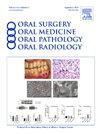Expression and clinical significance of U2AF homology motif kinase 1 in oral squamous cell carcinoma
IF 2
3区 医学
Q2 DENTISTRY, ORAL SURGERY & MEDICINE
Oral Surgery Oral Medicine Oral Pathology Oral Radiology
Pub Date : 2024-07-22
DOI:10.1016/j.oooo.2024.07.005
引用次数: 0
Abstract
Objective
U2AF homology motif kinase 1 (UHMK1) is a newly discovered molecule that may have multiple functions. Recent studies have revealed that UHMK1 had aberrant expression in many tumors and was associated with tumor progression. However, UHMK1 was rarely reported in oral squamous cell carcinoma (OSCC).
Study Design
In this study, Western blot, quantitative real-time polymerase chain reaction (PCR), and immunohistochemistry were used to detect the expression of UHMK1 in OSCC and peritumoral non-neoplastic tissues. Then, its relationship with clinicopathologic parameters was analyzed. The Kaplan–Meier method and Cox regression model were used to analyze the effects of UHMK1 expression on the prognosis and survival of OSCC patients.
Results
Our results showed that UHMK1 had higher expression in OSCC tissues compared with in peritumoral non-neoplastic tissues, and its high expression was associated with high TNM stage and lymph node metastasis. High UHMK1 expression was related to short overall and disease-free survival times. Moreover, UHMK1 expression was identified as an independent prognostic factor that influences overall and disease-free survival of OSCC patients.
Conclusions
High expression of UHMK1 is associated with the poor prognosis of patients, and it can be used as a potential prognostic molecule for OSCC.
U2AF 同源结构激酶 1 在口腔鳞状细胞癌中的表达及其临床意义
U2AF同源基序激酶1(UHMK1)是一种新发现的分子,可能具有多种功能。最近的研究发现,UHMK1 在许多肿瘤中都有异常表达,并与肿瘤进展有关。然而,UHMK1在口腔鳞状细胞癌(OSCC)中却鲜有报道。本研究采用Western印迹、定量实时聚合酶链反应(PCR)和免疫组织化学方法检测UHMK1在OSCC和瘤周非肿瘤组织中的表达。然后分析了其与临床病理参数的关系。采用Kaplan-Meier法和Cox回归模型分析了UHMK1表达对OSCC患者预后和生存的影响。结果表明,与瘤周非肿瘤组织相比,UHMK1在OSCC组织中的表达量更高,且其高表达与TNM分期和淋巴结转移相关。UHMK1 的高表达与总生存期和无病生存期的缩短有关。此外,UHMK1的表达被认为是影响OSCC患者总生存期和无病生存期的独立预后因素。UHMK1的高表达与患者的不良预后有关,可作为OSCC的潜在预后分子。
本文章由计算机程序翻译,如有差异,请以英文原文为准。
求助全文
约1分钟内获得全文
求助全文
来源期刊

Oral Surgery Oral Medicine Oral Pathology Oral Radiology
DENTISTRY, ORAL SURGERY & MEDICINE-
CiteScore
3.80
自引率
6.90%
发文量
1217
审稿时长
2-4 weeks
期刊介绍:
Oral Surgery, Oral Medicine, Oral Pathology and Oral Radiology is required reading for anyone in the fields of oral surgery, oral medicine, oral pathology, oral radiology or advanced general practice dentistry. It is the only major dental journal that provides a practical and complete overview of the medical and surgical techniques of dental practice in four areas. Topics covered include such current issues as dental implants, treatment of HIV-infected patients, and evaluation and treatment of TMJ disorders. The official publication for nine societies, the Journal is recommended for initial purchase in the Brandon Hill study, Selected List of Books and Journals for the Small Medical Library.
 求助内容:
求助内容: 应助结果提醒方式:
应助结果提醒方式:


